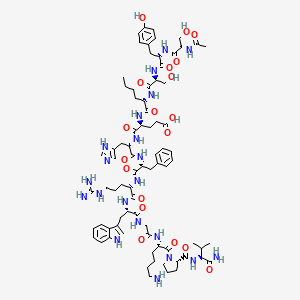



1. Afamelanotide Acetate
2. Cuv-1647
3. Cuv1647
4. Scenesse
1. Melanotan
2. Scenesse (tn)
3. Alpha-ndp-msh
4. [nle4,dphe7]alpha-msh
5. Melanotan 1
6. Afamelanotide (usan/inn)
7. Gtpl1324
8. Dtxsid40226843
9. Bdbm50017181
10. Db04931
11. Ncgc00167334-01
12. D10511
13. Q410794
| Molecular Weight | 1646.8 g/mol |
|---|---|
| Molecular Formula | C78H111N21O19 |
| XLogP3 | -3.5 |
| Hydrogen Bond Donor Count | 23 |
| Hydrogen Bond Acceptor Count | 22 |
| Rotatable Bond Count | 51 |
| Exact Mass | 1645.83651040 g/mol |
| Monoisotopic Mass | 1645.83651040 g/mol |
| Topological Polar Surface Area | 643 Ų |
| Heavy Atom Count | 118 |
| Formal Charge | 0 |
| Complexity | 3360 |
| Isotope Atom Count | 0 |
| Defined Atom Stereocenter Count | 12 |
| Undefined Atom Stereocenter Count | 0 |
| Defined Bond Stereocenter Count | 0 |
| Undefined Bond Stereocenter Count | 0 |
| Covalently Bonded Unit Count | 1 |
Afamelanotide is indicated for the prevention of phototoxicity in adult patients with erythropoietic protoporphyria (EPP).
Treatment of erythropoietic protoporphyria
Prevention of actinic keratosis, Prevention of drug phototoxic response, Treatment of congenital erythropoietic porphyria, Treatment of polymorphic light eruption, Treatment of solar urticaria
Afamelanotide increases the production of eumelanin, an endogenous photoprotective agent, to attenuate UV-induced skin damage in patients with a condition that predisposes them to phototoxicity. It has a relatively long duration of therapeutic effect despite its short half-life due to its ability to increase melanosome density and therefore skin pigmentation. As afamelanotide may darken pre-existing skin pigmentary lesions, patients receiving afamelanotide should undergo a full body skin examination every 6 months to monitor for progression or worsening of any skin abnormalities. Standard sun safety measures should continue to be employed during afamelanotide therapy.
Dermatologic Agents
Drugs used to treat or prevent skin disorders or for the routine care of skin. (See all compounds classified as Dermatologic Agents.)
D - Dermatologicals
D02 - Emollients and protectives
D02B - Protectives against uv-radiation
D02BB - Protectives against uv-radiation for systemic use
D02BB02 - Afamelanotide
Absorption
Afamelanotide is administered as a subcutaneous implant that slowly elutes active drug. Most of the dose is released within the first 48 hours, with >90% released by day 5. Plasma levels of afamelanotide decrease slowly over the course of several days following administration - by day 10, plasma levels were undetectable in most clinical trial subjects. Following administration of a single subcutaneous implant, the median Tmax was 36 hours, the mean Cmax was 3.7 1.3 ng/mL, and the mean AUC0- was 138.9 42.6 hr.ng/mL.
Route of Elimination
Minimal amounts of unchanged afamelanotide are recovered in the urine following administration, suggesting the drug is extensively metabolized and most likely eliminated primarily via fecal or biliary route.
Volume of Distribution
The apparent volume of distribution of afamelanotide following intravenous administration is approximately 0.54 L/kg.
Clearance
Data regarding plasma clearance of afamelanotide are limited. Plasma drug levels are typically undetectable at day 10 following subcutaneous administration of the afamelanotide implant.
Details regarding the metabolism and metabolites of afamelanotide are sparse. The drug is more resistant to degradation by serum and proteolytic enzymes than its endogenous counterpart, -MSH, but presumably undergoes a relatively rapid hydrolysis given its short half-life. It has been suggested that afamelanotide may be degraded in the same manner as -MSH but at a much slower rate, or may instead be degraded intracellularly via endocytosis or non-specific proteases.
The half-life of afamelanotide is approximately 30 minutes. The apparent half-life following administration of a slow-release subcutaneous implant is 15 hours.
Patients with erythropoietic porphyria (EPP) have a deficiency of ferrochelatase (FECH), an enzyme involved in the final step of heme biosynthesis. FECH is required to insert iron into protoporphyrin IX (PPIX) to generate heme, and a deficiency in FECH results in accumulation of PPIX (particularly in the liver and superficial skin vasculature). PPIX molecules are photodynamic - exposure to UV radiation causes these molecules to form reactive oxygen species that lead to subsequent tissue damage. Afamelanotide mimics endogenous alpha melanocyte-stimulating hormone (-MSH), a hormone typically released in response to UV-induced skin damage. Both afamelanotide and -MSH bind to the melanocortin-1 receptor (MC1R) on melanocytes which stimulates the synthesis of eumelanin, a photoprotective compound. Eumelanin is incorporated into small vesicles called melanosomes which are then distributed to surrounding keratinocytes. Melanosomes are concentrated above the nucleus of these keratinocytes, thus protecting them from UV-induced damage. While endogenous -MSH requires UV-induced skin damage in order to be produced, afamelanotide increases eumelanin biosynthesis independent of UV exposure. Activation of MC1R signalling by afamelanotide also instigates other protective processes, including an increase in antioxidant activity, DNA repair, and secretion of immunomodulatory proteins such as interleukin-10.
